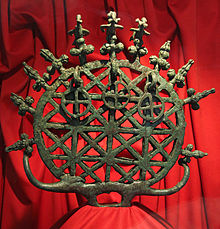
Back Bronstydperk Afrikaans Bronzezeit ALS ናስ ዘመን Amharic Edat de Bronce AN कांस्य युग ANP العصر البرونزي Arabic عصر برونزى ARZ ব্ৰঞ্জ যুগ Assamese Edá del bronce AST Tunc dövrü Azerbaijani
This article may require copy editing for grammar, style, cohesion, tone, or spelling. (January 2024) |

| Bronze Age |
|---|
| ↑ Chalcolithic |
| ↓ Iron Age |
| History of technology |
|---|
The Bronze Age was a historical period lasting from approximately 3300 to 1200 BC. It was characterized by the use of bronze, the use of writing in some areas, and other features of early urban civilization. The Bronze Age is the middle principal period of the three-age system, between the Stone and Iron Ages.[1] Worldwide, the Bronze Age generally followed the Neolithic period, with the Chalcolithic serving as a transition.
The Bronze Age is generally considered to have ended with the Late Bronze Age collapse, a time of widespread societal collapse between c. 1200 and 1150 BC. This collapse affected a large area of the Eastern Mediterranean, including North Africa and Southeast Europe, as well as the Near East, in particular Egypt, eastern Libya, the Balkans, the Aegean, Anatolia, and the Caucasus. It was sudden, violent, and culturally disruptive for many Bronze Age civilizations, and it brought a sharp economic decline to regional powers, most notably ushering in the Greek Dark Ages.
An ancient civilization is deemed to be part of the Bronze Age if it either produced bronze by smelting its own copper and alloying it with tin, arsenic, or other metals, or traded other items for bronze from producing areas elsewhere.
Bronze Age cultures were the first to develop writing. According to archaeological evidence, cultures in Mesopotamia, which used cuneiform script, and Egypt, which used hieroglyphs, developed the earliest practical writing systems.
- ^ The Metal Ages. Encyclopedia Britannica.
© MMXXIII Rich X Search. We shall prevail. All rights reserved. Rich X Search